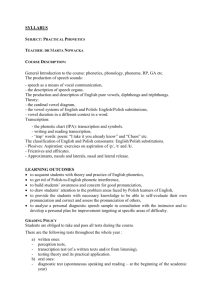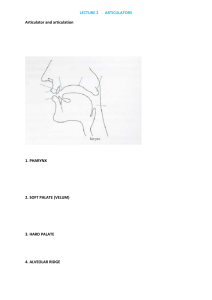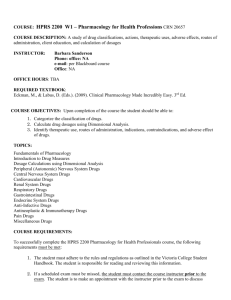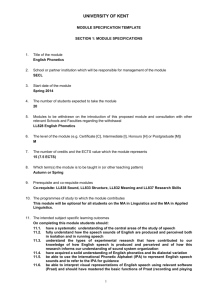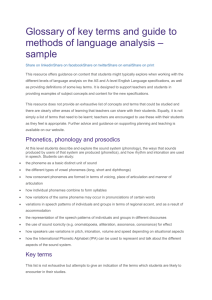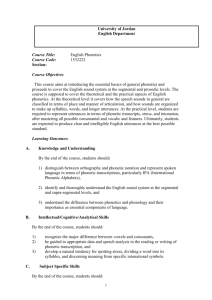PHONETICS - CSDS 307 - Longwood University
advertisement
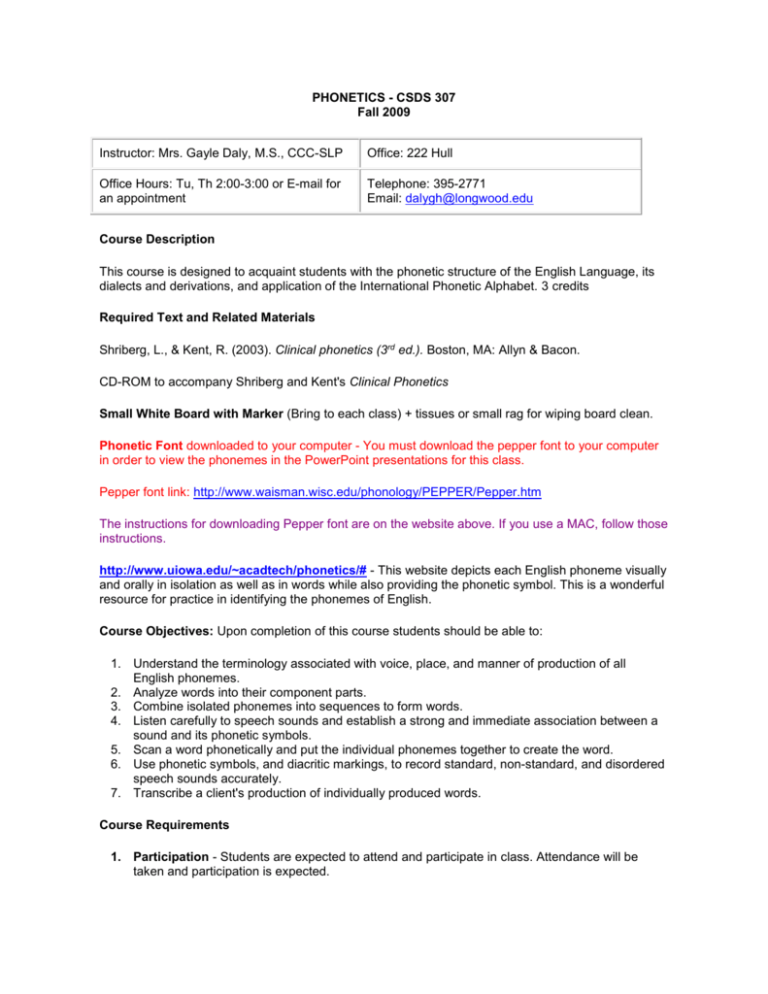
PHONETICS - CSDS 307 Fall 2009 Instructor: Mrs. Gayle Daly, M.S., CCC-SLP Office: 222 Hull Office Hours: Tu, Th 2:00-3:00 or E-mail for an appointment Telephone: 395-2771 Email: dalygh@longwood.edu Course Description This course is designed to acquaint students with the phonetic structure of the English Language, its dialects and derivations, and application of the International Phonetic Alphabet. 3 credits Required Text and Related Materials Shriberg, L., & Kent, R. (2003). Clinical phonetics (3rd ed.). Boston, MA: Allyn & Bacon. CD-ROM to accompany Shriberg and Kent's Clinical Phonetics Small White Board with Marker (Bring to each class) + tissues or small rag for wiping board clean. Phonetic Font downloaded to your computer - You must download the pepper font to your computer in order to view the phonemes in the PowerPoint presentations for this class. Pepper font link: http://www.waisman.wisc.edu/phonology/PEPPER/Pepper.htm The instructions for downloading Pepper font are on the website above. If you use a MAC, follow those instructions. http://www.uiowa.edu/~acadtech/phonetics/# - This website depicts each English phoneme visually and orally in isolation as well as in words while also providing the phonetic symbol. This is a wonderful resource for practice in identifying the phonemes of English. Course Objectives: Upon completion of this course students should be able to: 1. Understand the terminology associated with voice, place, and manner of production of all English phonemes. 2. Analyze words into their component parts. 3. Combine isolated phonemes into sequences to form words. 4. Listen carefully to speech sounds and establish a strong and immediate association between a sound and its phonetic symbols. 5. Scan a word phonetically and put the individual phonemes together to create the word. 6. Use phonetic symbols, and diacritic markings, to record standard, non-standard, and disordered speech sounds accurately. 7. Transcribe a client's production of individually produced words. Course Requirements 1. Participation - Students are expected to attend and participate in class. Attendance will be taken and participation is expected. 2. Tests - Two tests during the semester (75 pts each for 150 total) 3. Final Exam – The final exam is cumulative (150 points) 4. Quizzes - Because it is so crucial to success with phonetics for each student to keep up with the pace of class, there will be weekly quizzes. These quizzes will be short and will be varied in format, depending upon the nature of the material being covered. Quizzes might include transcribing live or taped recorded speech samples, definition of terminology, or outlining important points from the text or lectures. Each of the 11 quizzes will be worth 25 points, and the lowest grade will be dropped. THERE WILL BE NO MAKE-UP QUIZZES. If you miss a quiz that will be your dropped quiz. (250 points total) 5. Transcription Modules - Selected modules from Clinical Phonetics will be due at assigned periods during the semester. There will be 10 modules assigned during the semester. Each module will be worth 2 ½ points. No partial credit will be given for incomplete modules. (25 points total) 6. Transcription of 1 minute connected speech sample – information about this assignment will be shared in class. (25 points total) Grading Scale Grading Summary Points Scale Transcription Modules (2.5 points each) 25 pts 585-600 A+ 464-479 C+ Quizzes 250 pts 555-584 A 435-465 C Test 1 75 pts 540-554 A- 420-434 C- Test 2 75 pts 525-539 B+ 360-419 D Transcription Speech Sample 25 pts 495-524 B <360 F Final Exam 150 pts 480-495 B- TOTAL 600 pts Disability Statement The instructor is willing to meet reasonable accommodations for any student's documented disability. The student should bring supporting material to the instructor during the first week of class, including the accommodations needed, as outlined by the Disability Support Center at Longwood University. Honor Code and Class Attendance Students are expected to abide by the Longwood Honor Code, and all assignments and examinations must be pledged in order for a grade to be earned. The instructor will investigate any suspicion of an Honor Code infraction. Attendance in all class meetings is expected. ALL absences should be discussed with the instructor prior to time of absence, if possible. In accordance with the Longwood Attendance Policy, the class grade may be lowered one letter grade if the student misses 10% of class meetings and a grade of "F" may be assigned if a student misses 25% of class meetings. If a student is absent on a quiz or test date, without prior discussion with the instructor, the grade will be zero. Policy on Late Work: All assignments are due to the instructor at the beginning of class on the assigned due date. Work submitted late will be accepted, however a penalty will be incurred. Five % of the total point value of the assignment will be lost for each calendar day beyond the required submission date. No work will be accepted more than 1 week late. Class Schedule This schedule may be revised during the semester if necessary Date Topic Reading Aug. 25 Introduction, Syllabus review What is phonetics and why do you need to learn it? Aug. 27 Phonetics Overview Ch. 1 Sept. 1 Linguistic Phonetics Ch. 2 Sept. 3, 8 Systems of Speech Production Ch. 3 Sept. 10, 15, 17, 22, 24 Consonants Ch. 5 September 29 Test 1 Oct. 1, 6, 8 Vowels/Diphthongs Oct. 13 Fall Break (Enjoy) Oct 15, 20 Vowels/Diphthongs Oct.22, Suprasegmentals Oct. 27, 29, Nov. 3 Diacritics & Clinical Transcription Nov. 5 Test 2 Nov 10, 12, 17, 19, 24 Clinical Transcription Nov. 26 THANKSGIVING Dec. 1 Dialects Dec 3 Finish Dialects, Review for Final Exam Tues. Dec 10, 8:30 FINAL EXAM Ch. 4 Ch. 6, 7, 8, 9 Appendix F Additional Resources: Singh, S. and Singh, K. (2006). Phonetics: Principles and practices (3rd ed.). San Diego, CA: Plural. Small, L.H. (2005). Fundamentals of phonetics: A practical guide for students. Boston, MA: Allyn & Bacon.

